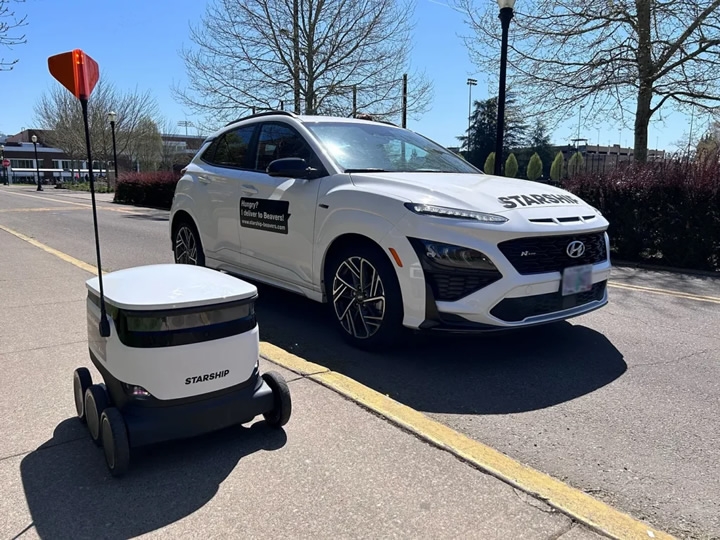Wheeled robots like ours are more efficient for the same reason cycling is more efficient than running, which includes less of a fight with gravity. The efficiency, as well as the sheer complexity of humanoid robots adds up to something that may be very much higher cost.
 Purpose-Built, Specialized Robots are the Future
Purpose-Built, Specialized Robots are the Future

Q&A with Lindsay Roberts, VP of Autonomous Driving | Starship
Tell us about yourself and your role with Starship.
I’ve been at Starship since it was six months old – when I first visited there were about 6 people crammed into a single room, adorned with robot parts and a lot of hopes and dreams. My background is software, at the tender age of 13 I begged my parents for my first software development kit. While that didn’t pan out as dreamt, I love programming, and that and a desire for adventure led me to move from Australia to Estonia to work at Skype. Years later, about a week after I left Skype, I got a call (Skype of course) from a friend: “Do you want to work on robots?” How to melt the heart of a software engineer. At Starship there was infinite to be done; a whole robot to make. Started out working on localization - how robots understand where they are in the world - for quite a few years, then popped over to also lead fleet orchestration for a while. Today I lead autonomous driving at the company, helping to make robots always more safe, autonomous and efficient as they navigate the ever increasing number of locations around the world.
There’s been a lot of buzz lately around humanoid robots, especially in logistics and delivery. Why do you believe purpose-built, specialized robots are the future—not humanoids?
While humanoid robots grab headlines, I think specialized, purpose-built robots are the future, especially as it pertains to logistics. Starship robots were designed from day one to solve a specific problem: delivering small items over short distances (up to 2 miles) safely and autonomously. That focus has allowed us to scale real-world operations across multiple countries. We’ve now completed over 10 million deliveries — something no other player in the industry can claim. Humanoids attempt to mimic general human function, but that often adds complexity without a clear benefit. Purpose-built robots like ours are simpler, more efficient, and easier to optimize for safety, battery life, and reliability.
Humanoid robots are fascinating, and an amazing feat of engineering. However, purpose-built robots will always be able to be smaller, as well as very significantly simpler and more efficient. Wheeled robots like ours are more efficient for the same reason cycling is more efficient than running, which includes less of a fight with gravity. The efficiency, as well as the sheer complexity of humanoid robots adds up to something that may be very much higher cost in many ways; they’ll be less reliable, more expensive to produce and run, and have a higher impact on the environment.
Starship robots were designed from day one to solve a specific problem: delivering small items over short distances (up to 2 miles) safely and autonomously. That focus has allowed us to scale real-world operations across multiple countries. We’ve now completed over 10 million deliveries — something no other player in the industry can claim.
Can you tell us more about how Starship’s autonomous delivery robots are being used at industrial sites like WACKER—and what made that deployment so successful?
At WACKER’s Burghausen site — one of Europe’s largest chemical production facilities — our autonomous delivery robots have become a key part of internal logistics. The robots transport lab samples, IT equipment, and small parts across the expansive campus, navigating safely and efficiently using a combination of sensors and pre-mapped virtual tracks. More than 95% of trips are fully autonomous, with remote support only as needed. Since the initial pilot in 2021, the system has scaled to regular operations with around 100 deliveries per week.
What made this deployment successful was the combination of WACKER’s clear vision for automation and Starship’s proven reliability. A collaborative rollout involving employees and apprentices helped with route mapping, infrastructure, and training — building trust and enthusiasm early on. The robots have been embraced as helpful, even personable, co-workers, contributing to a positive perception of automation across the workforce. Employees have even gone as far as dressing up the robots around Halloween and Christmas — spreading Holiday cheer across the site.
Following the success in Burghausen, our robots are now being expanded to additional WACKER sites including WACKER’s Nünchritz site, with interest from WACKER’s Charleston, Tennessee, USA plant.
You’ve also had success in more consumer-facing environments like university campuses. How does the design and functionality of your robots adapt to such different settings?
Our robots are designed to be highly adaptable - to operate in a very large range of densities and to coexist with the many participants of paved environments, which is key to their success across various environments — from industrial sites like WACKER to 60+ university campuses in the US, including George Mason University, Ole Miss, and UNC Charlotte, among others. On university campuses, we prioritize seamless integration with student life: robots navigate complex pedestrian areas, deliver from a wide range of dining locations, and integrate with third-party mobile platforms like Grubhub. The goal is to enhance convenience and reduce congestion while providing a fun, engaging experience for users. With features like real-time tracking, secure compartments, and playful/personal touches like seasonal music, our robots have become a beloved part of campus culture, completing millions of deliveries.
What makes these deployments so effective is our flexible platform and commitment to local collaboration. We tailor routes and workflows to each environment — whether that's mapping large industrial zones or optimizing service during peak lunch rush on a quad. Campuses benefit from increased operational efficiency and new revenue streams, including higher meal plan participation and late-night ordering without the cost of keeping storefronts open. It's this combination of smart autonomy, thoughtful design, and proven impact that allows our technology to thrive in both industrial and consumer-facing settings.
In your experience, what are the biggest misconceptions businesses or the public have when it comes to autonomous delivery or mobile robotics?
There are two big misconceptions we run into all the time. The first is that people assume autonomy means complexity — that deploying autonomous robots must be expensive, disruptive, or take years to integrate. But that’s simply not true with purpose-built robots like ours. At Starship, we’ve consistently demonstrated that mobile robotics can deliver immediate, measurable value without requiring an overhaul of existing operations. It does help that we’ve gotten pretty experienced at adding new areas, with over 150 locations running, we can integrate robots into the local environments even smoother.
The second misconception is this idea that robots have to look or behave like humans to be useful. We take the opposite approach. Our robots are designed for specific jobs — whether that’s last-mile delivery on a university campus or transporting materials around an industrial site — and they do those jobs extremely well. You don’t need a humanoid to carry your lunch or deliver a spare part.
Some people worry robots might replace human jobs, but your recent deployments tell a different story. How do Starship’s robots fit alongside—rather than replace—human workers?
It’s an important question — and one we hear often. But the reality is, our robots are designed to complement human workers, not replace them. They handle repetitive, low-value tasks like short-distance deliveries or material transport, which frees people up to focus on higher-impact, more rewarding work. That’s exactly what we’ve seen at industrial sites like WACKER, where employees welcomed the robots as a way to make their jobs more efficient — and more enjoyable. We’ve even seen teams dress them up for holidays, which says a lot about how quickly they’ve become part of the culture.
The benefits go beyond the workplace, too. Our robots improve accessibility, especially on college campuses where students who may face mobility challenges can get meals or supplies delivered right to them. We’re also proud that many students get the chance to work with our robots — whether it’s helping manage the fleet, troubleshooting, or gaining experience with robotics technology — and that often leads to jobs after graduation.
And of course, there’s the sustainability piece. Every delivery made by a small, electric robot instead of a car helps reduce emissions and traffic congestion — making communities better for everyone. So when we talk about robots fitting alongside people, it’s not just in the workplace, but as part of a broader ecosystem that creates opportunity, improves accessibility, and builds a more sustainable future.
Looking ahead, where do you see the greatest opportunities—and the greatest challenges—for autonomous, purpose-built robots over the next 5 years?
The opportunity is massive. We’re just scratching the surface of how purpose-built robots can improve everything from logistics and delivery to manufacturing and industrial operations. Anywhere there’s a repetitive, short-distance movement of goods — that’s where autonomy can make a huge difference in efficiency, cost, and even sustainability.
But the challenge is cutting through the hype. There’s a lot of noise in the robotics space right now — flashy prototypes, humanoid robots that look great on stage but aren’t solving real-world problems yet. We believe success comes down to designing robots that are practical, reliable, and purpose-built for the job at hand. That’s how we’ve scaled to over 8 million deliveries already, and that’s the mindset we’ll stick with as the industry grows.
And personally, I see our robots as a near infinite plane of opportunity. We’re working to automate the short-range movement of goods, similar to how the modern telephone exchange automated the flow of voice. It never stops being exciting, knowing you can’t even imagine all that might be possible.

Lindsay Roberts is VP of Autonomous Driving at Starship Technologies, where he leads the development of the company’s self-driving robots. Having joined Starship in its earliest days nearly a decade ago, he’s held a range of leadership roles helping grow the company from a scrappy startup to a global delivery robotics leader. Prior to Starship, Lindsay worked at Skype in Estonia leading up to its acquisition by Microsoft.
The content & opinions in this article are the author’s and do not necessarily represent the views of RoboticsTomorrow
Featured Product

